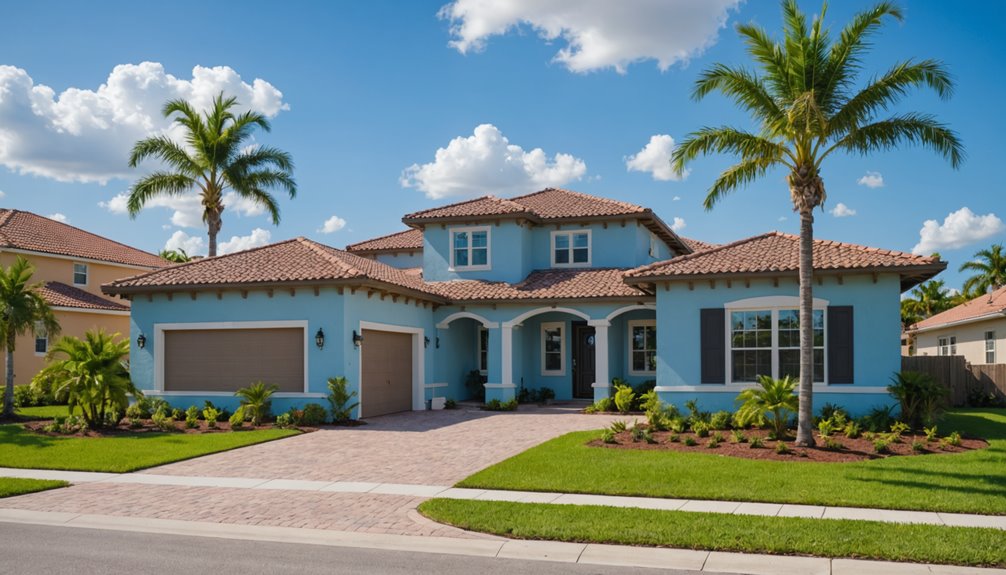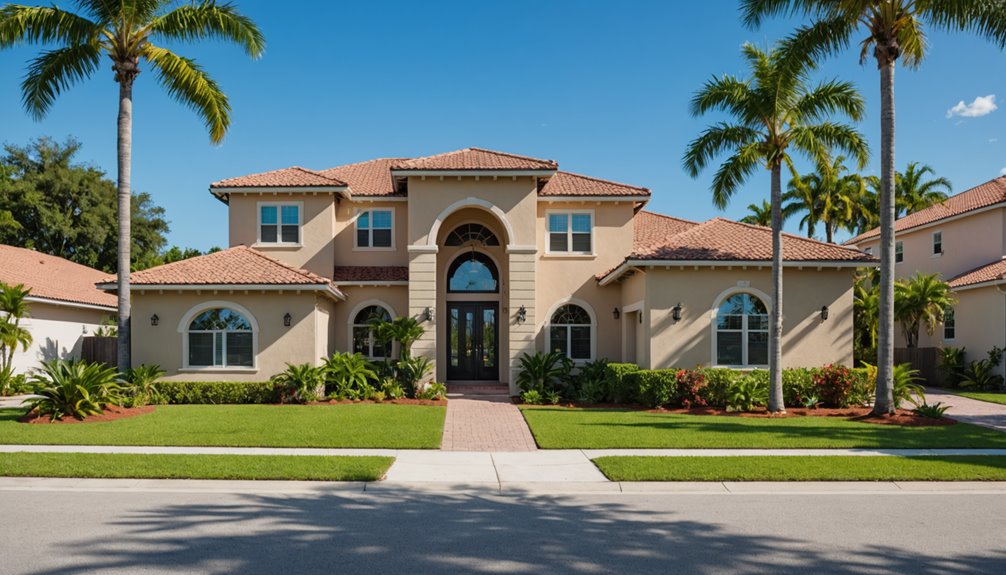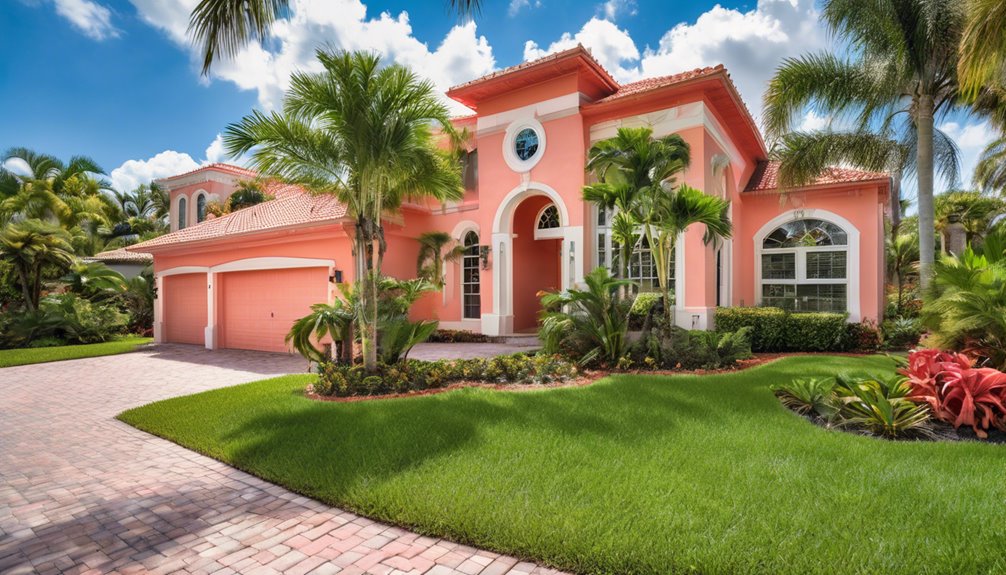Florida’s single-family home market is thriving, with demand surging in coastal and suburban areas as the population is projected to reach nearly 25 million by 2030. Median prices are expected to hover at $420,000 for 2025, while mortgage rates stand at 7.19% for 30-year fixed loans, posing a challenge to affordability. Inventory has grown 133% since 2022, offering more choices, yet affordable homes under $400,000 are scarce. Regional price variations also impact decisions. Investigate further to gain deeper insights into this dynamic market.
Key Takeaways
- Florida’s median home price is $420,000 in 2025, with slight moderation expected.
- Mortgage rates are currently high at 7.19% for a 30-year fixed-rate mortgage, negatively impacting affordability.
- Inventory surged 133% since 2022, offering buyers more choices.
- Coastal areas tend to experience steeper price corrections than inland regions.
- Builders offer incentives, such as rate buy-downs, to attract buyers.
Current Market Trends for Florida Homes
As Florida continues to attract a surge of new residents, the housing market for single-family homes reflects a dynamic interplay of growth and challenges. With the state’s population projected to exceed 25 million by 2030, demand for Florida single-family homes for sale soars, particularly in coastal and suburban areas. Migration from other states and foreign investment, especially in Miami and Fort Lauderdale, intensifies this need, while suburban expansion offers more accessible options.
Inventory is stabilizing at 5.6 months as of May 2025, providing buyers with more choices, although construction delays persist due to labor shortages. Additionally, the increased housing inventory reflects a shift towards a buyer’s market, allowing buyers to exercise more negotiation power. Median home prices, forecasted at $420K for 2025, show a slight moderation. Furthermore, home sales are expected to reach approximately 4,450 units by year-end 2025, representing a modest 6% increase from previous years. Join this vibrant community by exploring Florida’s evolving housing opportunities today.
Interest Rates and Buying Affordability
How do interest rates shape the path to owning a single-family home in Florida? For buyers, the current landscape, with 30-year fixed mortgages at 7.19% and 15-year at 6.44% as of July 2025, directly impacts affordability. Higher rates raise monthly payments and qualification thresholds, while forecasts of a decline to around 6.3% by late 2025 offer hope. Market trends and inflation further influence these trends, making it challenging for aspiring homeowners to navigate. Additionally, median home prices in Florida have surged, meaning buyers may need larger loans to afford their dream homes.
Consider these key points to navigate the market:
- Monitor Rate Forecasts: Anticipate declines to 6.5% by year-end 2025.
- Explore Loan Options: Adjustable-rate mortgages may provide short-term relief.
- Leverage Incentives: Utilize tax advantages, such as the increase in the SALT deduction cap.
- Plan Strategically: Align purchases with projected rate stabilization for better affordability.
Inventory and New Construction Updates

While interest rates continue to shape affordability, the inventory of single-family homes in Florida presents a crucial factor for prospective buyers. With a statewide 5.6-month supply, the market nears a balanced state, offering fairer negotiations between buyers and sellers. Active inventory has surged 133% since May 2022, reaching 177,000 homes in 2025, though it remains below pre-crisis levels. Regional disparities, such as Miami-Dade’s 5,530 units—still 20% below pre-pandemic figures—highlight the need for local expertise. An agent’s insider information can help buyers navigate these inventory dynamics effectively. Affordable options below $400,000 are scarce, comprising just 2% of listings, while high-end homes dominate. Sellers, bolstered by past equity gains, now offer concessions to attract buyers. This shift is further evidenced by a 31.6% year-over-year increase in inventory for single-family homes, signaling more options for buyers. For those seeking a place in Florida’s vibrant communities, understanding these inventory dynamics is vital to making informed decisions.
Key Demand Factors Shaping the Market
Beyond the fluctuations in inventory, several key demand factors are shaping the market for single-family homes in Florida. Mortgage rates averaging 6.5% challenge affordability, yet builders and lenders offer incentives, such as rate buy-downs, to ease the costs. Stabilizing median prices at $415,000, down 2.7% year-over-year, boosts perceived value, drawing buyers back. Consumer behavior shifts show a preference for quicker resale homes amid new construction delays of 9–12 months. Additionally, the increasing inventory, with a 5.6-month supply for single-family homes, offers buyers more choices and less competition. These dynamics equip buyers with a negotiating advantage and informed choices. Understanding local market conditions is crucial for making informed strategic decisions in this rapidly evolving landscape.
Join this evolving market by considering:
- *Exploring lender incentives to offset high mortgage rates.*
- *Prioritizing resale homes for faster move-in timelines.*
- *Utilizing stabilized pricing for long-term value.*
- *Consulting property agents to navigate financing and inventory options.*
Regional Price Differences Across Florida

Florida’s single-family home market reveals notable disparities when examining regional price trends. At the same time, the statewide median price for single-family homes decreased to $412,734 in April 2025, a 4% year-over-year decline. Areas like Tampa Bay report slightly lower medians at $410,000. Coastal markets are more likely to face steeper corrections due to increased competition from new construction, whereas inland and exurban regions tend to experience slower declines. Orlando and Tampa Bay maintain consistent demand, offering stability for buyers seeking community. Understanding housing market trends enables buyers to find their ideal place in Florida’s diverse housing landscape, aligning with both their budget and lifestyle aspirations.
| Region | Median Price (2025) | YoY Change |
|---|---|---|
| Statewide | $412,734 | -4.0% |
| Tampa Bay | $410,000 | Below Avg |
| Coastal Markets | Varies | Steeper Drop |
Frequently Asked Questions
What Are the Best Florida Neighborhoods for Families?
Identifying the best Florida neighborhoods for families reveals that Palm Harbor, Harbour Island, and Winter Garden stand out as top choices. These areas offer excellent schools, safety, and community amenities, creating a welcoming environment that fosters a sense of belonging for families.
How Do Property Taxes Impact Home Buying?
Property taxes significantly influence home buying decisions, affecting affordability that varies by location, and potentially straining budgets. Understanding property taxes and exemptions helps buyers join communities confidently, ensuring financial stability within their chosen neighborhoods.
Are There Specific Home Insurance Challenges in Florida?
Home insurance in Florida presents distinct challenges. High premiums, limited provider options, frequent non-renewals, and climate-driven risks create significant uncertainty. Joining this community means navigating these hurdles, but understanding them fosters confidence in securing the proper coverage.
What Are Common Closing Costs for Buyers?
Understanding common closing costs is essential for buyers. These typically range from 2% to 5% of the purchase price, covering lender fees, appraisals, and title insurance, ensuring a smooth and confident home-buying experience for all.
How Do HOA Fees Affect Affordability?
HOA fees markedly impact affordability by adding to monthly housing costs. For many, these fees strain budgets, yet they foster community through shared amenities. Understanding their impact is vital for informed and connected homeownership decisions.
Conclusion
As buyers navigate the Florida single-family home market, they may find that their dream home aligns perfectly with current trends, whether it’s a dip in interest rates or a surge in new construction. With regional price variations and key demand factors at play, now could be the opportune moment to act. Armed with this knowledge, prospective homeowners are encouraged to seize the opportunity and make their Florida dream a tangible reality.
References
- https://www.bcpmortgage.com/post/florida-housing-market-trends-2025
- https://jaredjones.com/2025/07/10/florida-housing-market-orlando-2025-update/
- https://movingtofloridaguide.com/understanding-the-florida-real-estate-market-from-the-experts.html
- https://www.hco.com/insights/florida-housing-market
- https://realatlas.com/florida-housing-market-2025-buyers-trends/
- https://www.miamirealtors.com/2025/04/04/2025-2026-southeast-florida-housing-outlook-modest-home-sales-and-price-growth/
- https://www.bankrate.com/mortgages/mortgage-rates/florida/
- https://www.makefloridayourhome.com/florida/research/rates-forecast
- https://www.floridarealtors.org/news-media/news-articles/2025/04/rates-expected-move-lower-2025-2026
- https://www.miamirealtors.com/2025/07/07/southeast-florida-housing-outlook-june-2025-update-home-sales-rebound-in-2026-as-mortgage-rates-decline-to-below-6/







